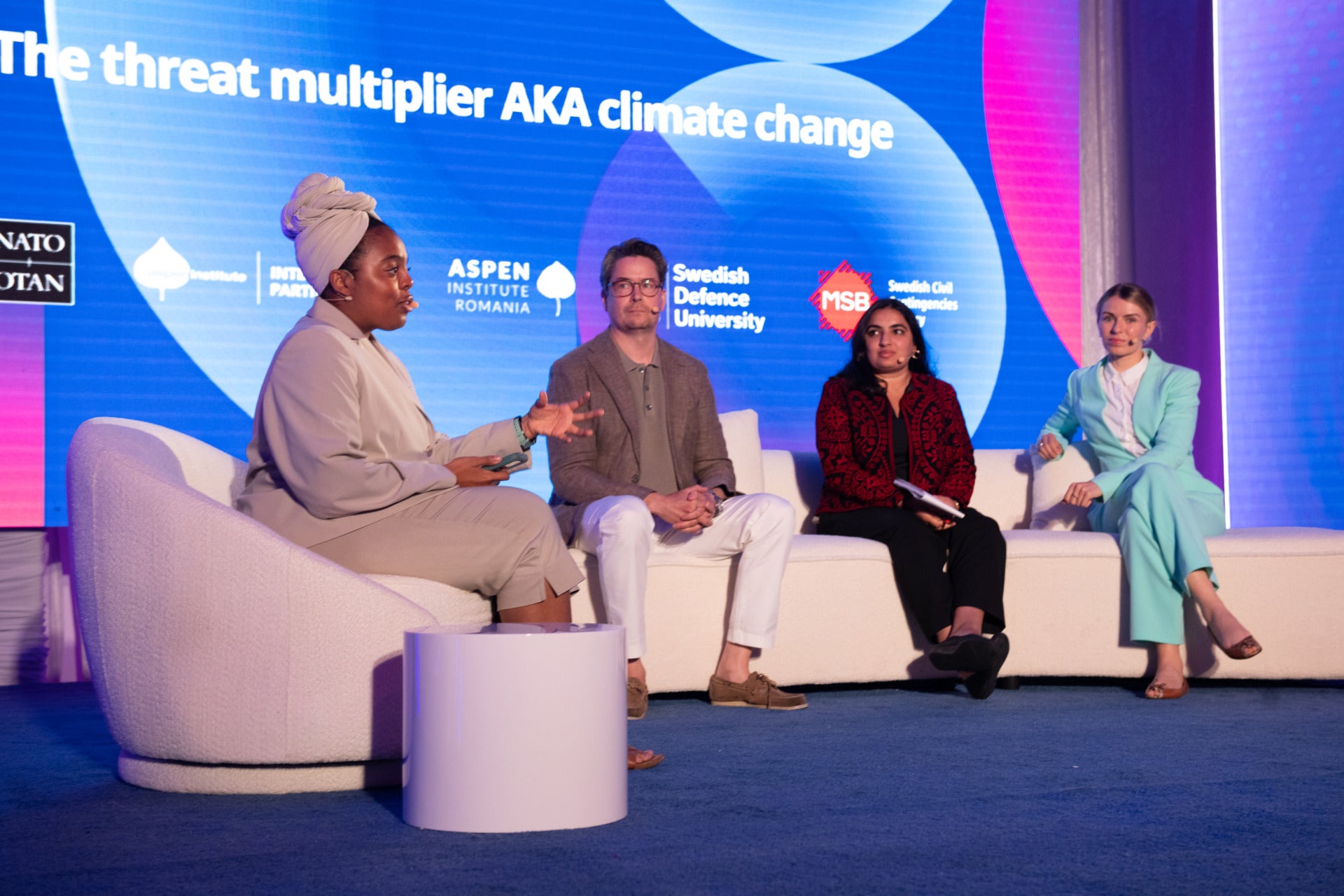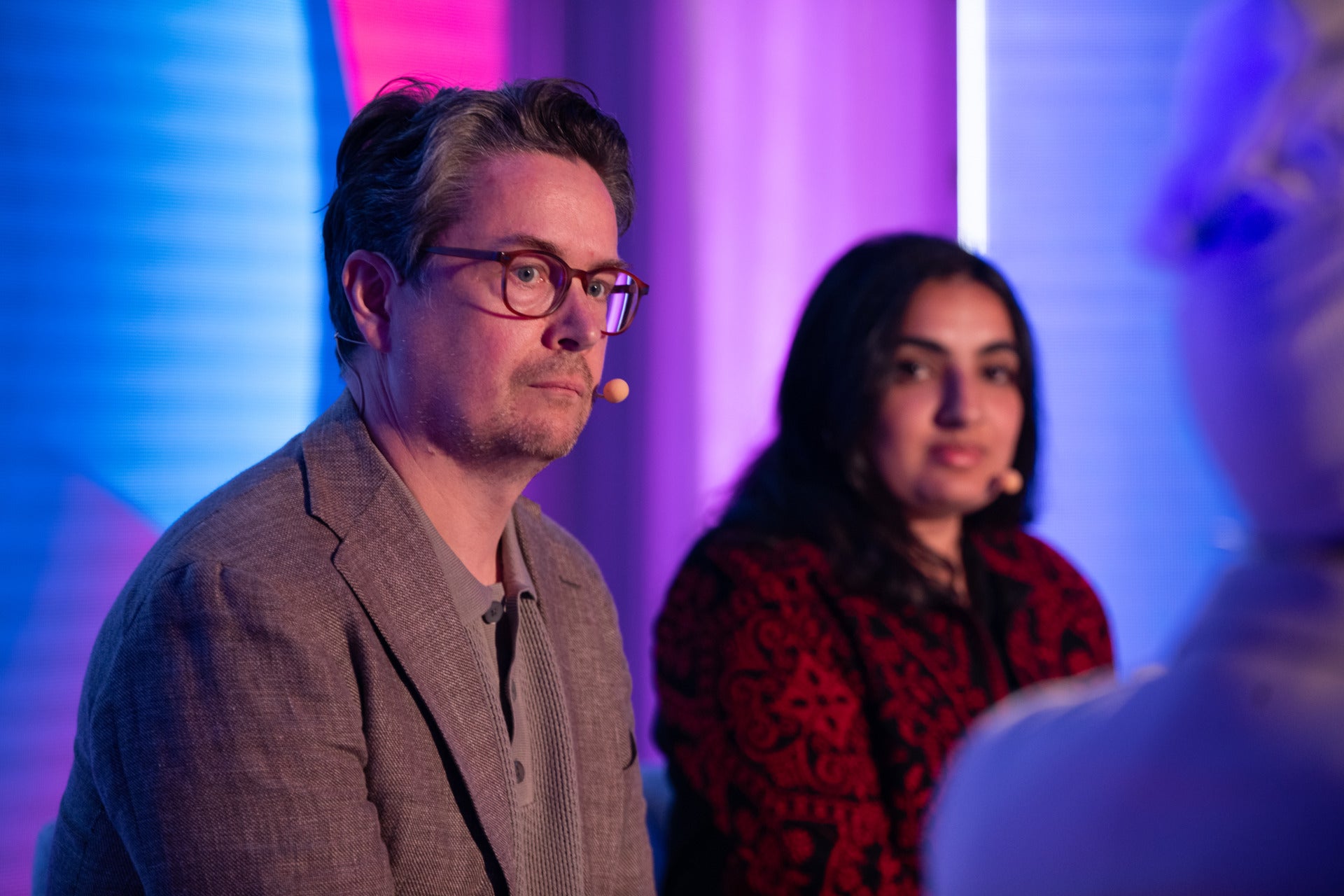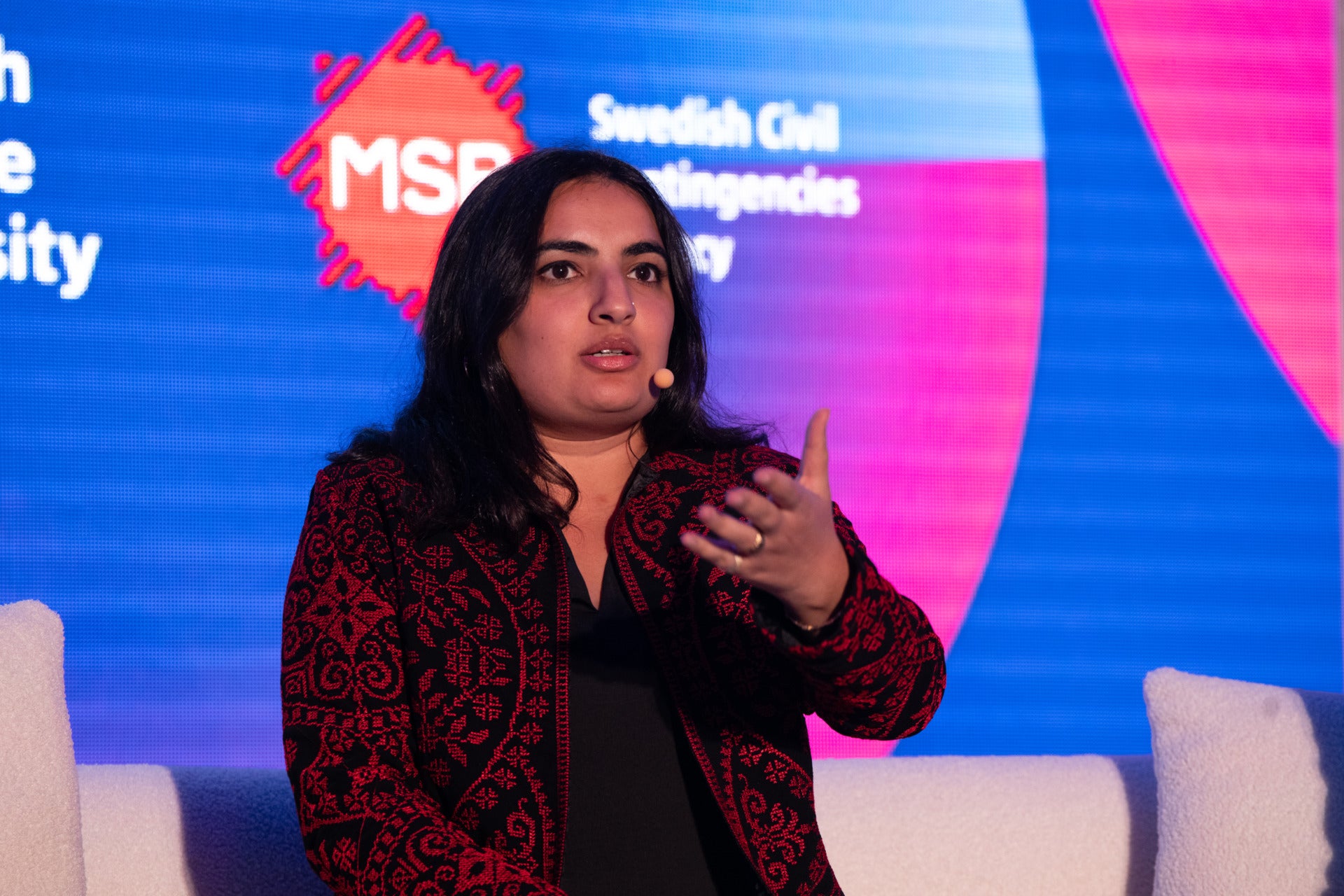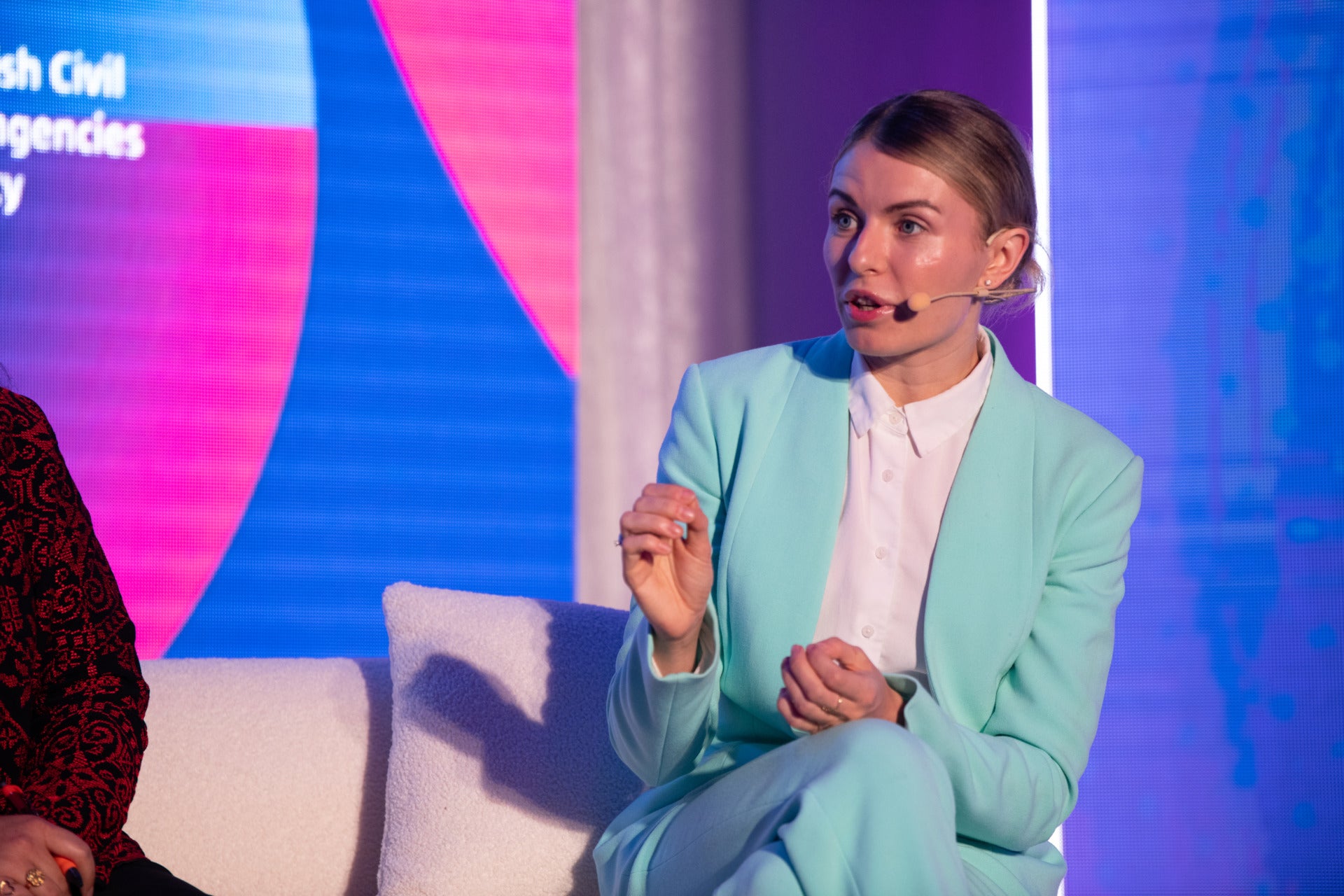Displacement. Food scarcity. Poverty. Polarization.
These were just a few of the responses to the question “what are the ways climate change acts as a threat multiplier in your community?” when it was posed to the audience at the 2024 NATO Youth Summit. The summit, organized in part by Aspen Institute International Partners and Aspen Institute Romania, convened young people from around the world to address pressing global challenges, including disinformation, emerging technologies, national defense, and what many believe to be the greatest threat to humanity of all: climate change.
But what does the North Atlantic Treaty Organization—a political and military peacekeeping alliance formed in the aftermath of World War II—have to do with the climate crisis?

From L to R: Cameron Oglesby, Samu Paukkunen, Pooja Tilvawala, Lesia Vasylenko. Photo by Anthony Nader.
Onstage at the NATO Youth Summit in Miami, Florida, experts discussed the geopolitical implications of climate change as a threat multiplier, and NATO’s efforts in environmental security and environmental protection. Keep reading to explore key takeaways from the conversation, moderated by Cameron Oglesby, environmental justice advocate, storyteller, and Aspen Institute Future Leader Climate Fellow.
Nothing is as detrimental to our fight against climate change as war.
“Our priority today in Ukraine is survival,” said Lesia Vasylenko, a member of the parliament of Ukraine. “The main dialogue in Ukraine is the issue of physical survival, and often that survival–fighting back on the battleground–means that we have to compromise on the climate change front.”
Vasylenko sits on the environmental committee in the parliament of Ukraine, and she chairs the subcommittee on climate change. When Russia invaded Ukraine in early 2022, she was forced to grapple with the difficult compromises that war brings to a country.
“When you are faced with the threat of physical extermination, you do not care what weapon you pick up to fight back,” she said. “When somebody is breaking into your house, you’re not going to be thinking: “Should I fire a gun or not fire a gun? Will this impact the environment? How will this impact the environment?” No, you just pick up whatever you can and you start defending yourself.”
Vasylenko went on to explain that, while new military technologies are being developed that run on hydrogen and other more environmentally friendly biofuels, these technologies are only in their nascent states, are very expensive, and are not necessarily available for all Ukrainian soldiers to be trained in.
“If you ask any soldier, “What would you rather use–a tank that runs on hydrogen or a conventional tank that runs on diesel?” they will choose the one that runs on diesel because they know how to service it, they know how to use it, they know that it’s reliable. This is why wars, they will always be major, major contributors to climate change and to deteriorating the environment.”
Scientists have taken steps to quantify the environmental impact of Russian aggression in Ukraine. In a report by the Initiative on GHG Accounting of War led by Lennard de Klerk, it is estimated that greenhouse gas emissions caused by the war amount to over 150 million tons of CO2–more than the annual emissions of a highly industrialized country like Belgium.
NATO has a significant role to play in both adapting to and mitigating the impacts of climate change.
“Only by deterring adversaries are we able to invest in fighting climate change,” said Samu Paukkunen, NATO’s head of climate and energy security, explaining the importance of a peacekeeping alliance in the climate movement.
When asked about how to communicate about the interconnectedness of these crises in a way that ensures the individual or political nuances are not muddled, Paukkunen pointed to the importance of specific, relatable examples that bring these big ideas close to home.
“Here in Miami, global warming and sea level rise are impacting the hundreds of thousands of people who live here. But it’s also having an impact several hundred miles north in Norfolk–home to the largest naval base in the world–where weather patterns are going to have an impact on the operations, on the maintenance, on the staff, the personnel working there.”
“In northern Europe, because of global warming, some of the northern airfields are not at our disposal anymore, so planes have to be based on more southern bases. When we go eastwards to the Russian Arctic, we see a situation where the thawing of permafrost is leading to a situation where anthrax is becoming again a real possibility–anthrax spreading because of global warming.”
“It is by these examples that we actually learn what are the interlinkages between climate change and security, and there are thousands and thousands,” Paukkunen expressed. “And it is NATO’s role to connect these dots and do this analysis.”

Samu Paukkunen at the NATO Youth Summit. Photo by Anthony Nader.
Paukkunen also emphasized the importance of “climate-proofing” NATO, so that the Alliance itself can withstand the challenges of tomorrow.
“We already have black days for helicopters. When it’s more than 50°C, they cannot operate in that kind of environment. We have a situation in the High North area that, due to global warming, some of that ice is drifting to more southern parts. So we have to figure out how we can operate there now with the forces that we have.”
“There are so many issues that we need to take into account when we are planning ahead, when we are adapting to the changes caused by the climate crisis. It needs to be interwoven in all of the processes within NATO. I think that’s the only way that we can safeguard this alliance.”
Climate solutions must be intergenerational and young people belong in spaces where decisions are being made.
Following years of advocacy by young people from around the world, the UN Security Council unanimously adopted a historic resolution in 2015 that urged member states to give youth a greater voice in decision-making at all levels of governance. In 2021, NATO launched its 2030 Initiative that included a group of 14 young leaders from across the Alliance who developed a report outlining their recommendations for strengthening NATO’s future. These developments recognize the inclusion and participation of young people as a key dimension of building and sustaining peace and security for all–but there’s still more work to be done.
As the founder and executive director of the Youth Climate Collaborative, a youth-led organization advancing social and intergenerational equity in the climate space, Pooja Tilvawala has dedicated her career to activating and sustaining youth voices. She’s seen firsthand the impact that intergenerational power sharing can have in developing effective climate solutions.

Pooja Tilvawala at the NATO Youth Summit. Photo by Anthony Nader.
“As young people, we are culture shapers. We remind people of the values of democracy. We are policymakers. We demand accountability of our leaders. We’re entrepreneurs, we’re creatives,” Tilvawala said when asked about the importance of engaging youth in climate security solutions. “Protest alone does not go far enough. But I’ve rarely ever seen protests unaccompanied by deeper policy work. In some ways, protests are a great recruitment for this approach.”
Even if young people aren’t always given a seat at the table in high-level decision-making, they’re still using the tools they have at their disposal to make an impact.
“Youth are taking corporations and governments to court even before even taking a class on politics or government. Youth are creating evidence-based social media content to educate their peers. Youth are demanding a transition to intergenerational decision-making bodies and setting up climate councils,” she shared.
Paukkunen felt similarly: “I’ve had many discussions with politicians and policymakers, and what encourages me is that they feel that they get support from the youth. That it is the youth that is pushing them to make the hard decisions. This hasn’t always been there.”
“With this kind of support, I think we have a chance.”

Lesia Vasylenko at the NATO Youth Summit. Photo by Anthony Nader.
Watch the full session here, and learn more about the NATO Youth Summit that took place earlier this month.

